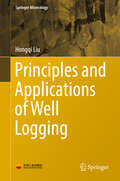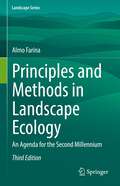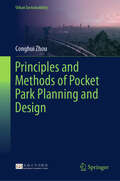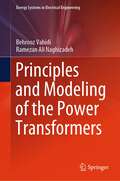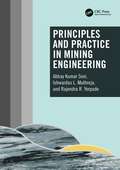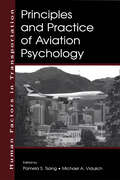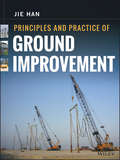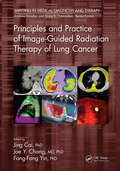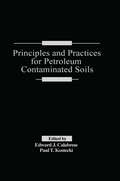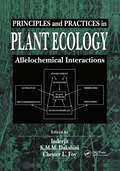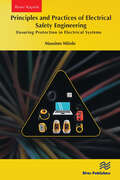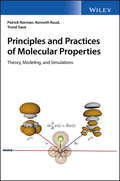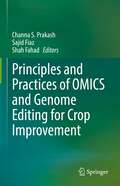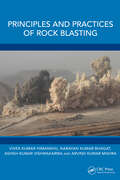- Table View
- List View
Principles and Applications of Well Logging
by Hongqi LiuThis book primarily focuses on the principles and applications of electric logging, sonic logging, nuclear logging, production logging and NMR logging, especially LWD tools, Sondex production logging tools and other advanced image logging techniques, such as ECLIPS 5700, EXCELL 2000 etc. that have been developed and used in the last two decades. Moreover, it examines the fundamentals of rock mechanics, which contribute to applications concerning the stability of borehole sidewall, safety density window of drilling fluid, fracturing etc. As such, the book offers a valuable resource for a wide range of readers, including students majoring in petrophysics, geophysics, geology and seismology, and engineers working in well logging and exploitation.
Principles and Applications of Well Logging
by Hongqi LiuThis book primarily focuses on the principles and applications of electric logging, sonic logging, nuclear logging, production logging and NMR logging, especially LWD tools, Sondex production logging tools and other advanced image logging techniques, such as ECLIPS 5700, EXCELL 2000 etc. that have been developed and used in the last two decades. Moreover, it examines the fundamentals of rock mechanics, which contribute to applications concerning the stability of borehole sidewall, safety density window of drilling fluid, fracturing etc. As such, the book offers a valuable resource for a wide range of readers, including students majoring in petrophysics, geophysics, geology and seismology, and engineers working in well logging and exploitation.
Principles and Applications of Well Logging (Springer Mineralogy)
by Hongqi LiuThis book primarily focuses on the principles and applications of electric logging, sonic logging, nuclear logging, production logging and NMR logging, especially LWD tools, Sondex production logging tools and other advanced image logging techniques, such as ECLIPS 5700, EXCELL 2000 etc. that have been developed and used in the last two decades. Moreover, it examines the fundamentals of rock mechanics, which contribute to applications concerning the stability of borehole sidewall, safety density window of drilling fluid, fracturing etc. As such, the book offers a valuable resource for a wide range of readers, including students majoring in petrophysics, geophysics, geology and seismology, and engineers working in well logging and exploitation.
Principles and Applications of X-ray, Light and Neutron Scattering
by Takeji HashimotoThis book provides insight into the underlying basic theories and concepts in X-ray, light, and neutron scattering. The three scattering principles are systematically presented, together with a unified description based on elastic scattering of electromagnetic waves and the Schrödinger wave from matter. These explanations are presented with an introduction of their common Born approximation using a consistent set of symbols and terminology and with step-by-step derivations of equations. This book emphasizes the combined applications of these three scattering methods, wherever and whenever possible, as a very powerful methodology for characterization of internal structures of soft matters in the length scale ranging from subnanometers to a few 10 micron meters. These applications include explorations for evolution of hierarchically self-organized internal structures of a variety of soft matters, including cells, under diverse environmental conditions.This book will not only be an excellent resource for graduate students and academic researchers who analyze structures of soft matters and polymers, but it will also be useful for researchers in industries.
Principles and Case Studies of Simultaneous Design
by William L. LuybenThere are many comprehensive design books, but none of them provide a significant number of detailed economic design examples of typically complex industrial processes. Most of the current design books cover a wide variety of topics associated with process design. In addition to discussing flowsheet development and equipment design, these textbooks go into a lot of detail on engineering economics and other many peripheral subjects such as written and oral skills, ethics, "green" engineering and product design. This book presents general process design principles in a concise readable form that can be easily comprehended by students and engineers when developing effective flow sheet and control structures.Ten detailed case studies presented illustrate an in-depth and quantitative way the application of these general principles. Detailed economic steady-state designs are developed that satisfy economic criterion such as minimize total annual cost of both capital and energy or return on incremental capital investment. Complete detailed flow sheets and Aspen Plus files are provided. Then conventional PI control structures are be developed and tested for their ability to maintain product quality during disturbances. Complete Aspen Dynamics files are be provided of the dynamic simulations.
Principles and Methods in Landscape Ecology: An Agenda for the Second Millennium (Landscape Series #31)
by Almo FarinaThis third, thoroughly updated edition of a well received book, presents the most complete collection of theories, paradigms and methods utilized by the landscape sciences. With the introduction of new ecosemiotic concepts and innovative managing procedures, it offers a broad list of ecological, ecosemiotical and cultural tools to investigate, interpret and manage the environmental complexity according to a species-specific individual-based approach. Readers will discover the importance of a landscape perspective to create strategic bridges between science and humanities favored by the holistic sight of sensorial (visual, acoustic, olfactory, tactile, and thermal) “scapes”.Distributed in 10 chapters, the content covers many aspects of the landscape sciences ranging from the description of fundamental theories, principles and models originated by ecological approaches like source-sink models, island biogeography, hierarchical theory and scale. The ecosemiotical approaches like the eco-field model, the ecoscape paradigm, and the general theory of resources are widely described and discussed. A cultural approach to landscape is utilized to focus on the heritage values of territories and their environmental identity. This book, written in an accessible and didactic style, is particularly dedicated to undergraduate and graduate students but also scholars in ecology, agroforestry, urban planning, nature design, conservation and remediation. Land practitioners, farmers and policymakers can use this book as an authoritative guide to better understand the function and role of environmental systems according to a social-economic integrated perspective.
Principles and Methods of Pocket Park Planning and Design (Urban Sustainability)
by Conghui ZhouThis book focuses on the planning and design methods of pocket parks in the disciplines of urban planning and landscape architecture. It fills the gap in the current pocket park planning by innovatively exploring the service mechanism and planning methods of the pocket parks to alleviate the scarcity of outdoor recreational spaces in the high-density environments. This book integrates the results of previous research and our latest research results. Taking urban renewal as the planning scenario, the book systematically introduces the basic characteristics of mini-parks, planning principles and methods, and development promotion and assurance strategies. This book is used as a textbook for planning and design courses, as well as a professional reference book for urban planners and landscape architects. The authors have also made great efforts to use simple language and a large number of visual illustrations in the text. Through these approaches, the authors expected that the publication of this book would not only facilitate teaching and practical application, but also attract more interest and attention from ordinary people, and motivate them to actively participate in the planning, design, and management of mini-parks around them. Only when this goal is achieved, can the original value of mini-park development be finally realized.
Principles and Modeling of the Power Transformers (Energy Systems in Electrical Engineering)
by Behrooz Vahidi Ramezan Ali NaghizadehThis book describes many aspects of power transformers. And it mainly provides valuable knowledges such as two deals with power transformer construction, different types of transformers and connections, power transformer core modelling, and the low-frequency and mid-frequency modelling of transformers. Moreover, it also introduces a new method for high-frequency modelling of transformer which can attract many students learning the power transformer research field. The goal of this book is to educate the postgraduate students and engineers about principals and modeling of the transformers.
Principles and Modern Applications of Mass Transfer Operations
by Jaime BenitezA problem-solving approach that helps students master new material and put their knowledge into practiceThe Second Edition of the acclaimed Principles and Modern Applications of Mass Transfer Operations continues to provide a thorough, accessible text that gives students the support and the tools they need to quickly move from theory to application. This latest edition has been thoroughly revised and updated with new discussions of such developing topics as membrane separations, ion exchange, multistage batch distillation, and chromatography and other adsorptive processes. Moreover, the Second Edition now covers mass transfer phenomena in biological systems, making the text appropriate for students in biochemical engineering as well as chemical engineering.Complementing the author's clear discussions are several features that help students quickly master new material and put their knowledge into practice, including:Twenty-five to thirty problems at the end of each chapter that enable students to use their newfound knowledge to solve problemsExamples and problems that help students become proficient working with MathcadFigures and diagrams that illustrate and clarify complex concepts and processesReferences facilitating further in-depth research into particular topicsTen appendices filled with helpful data and reference materialsIdeal for a first course in mass transfer operations, this text has proven to be invaluable to students in chemical and environmental engineering as well as researchers and university faculty.
Principles and Practice in Mining Engineering
by Abhay Kumar Soni Ishwardas L. Muthreja Rajendra R. YerpudePrinciples and Practice in Mining Engineering is an up-to-date introduction to the scientific principles and technological practices of mining engineering. This book introduces the processes involved in surface and underground mining, and covers many topical issues common to mining engineering practices, including mining and quarrying methods, environmental protection measures, finance and investment, policy and mining education. Recent technology and innovations (technovations) in the mining and mineral industry, including digital mines, IoT/IIoT, AI, and machine learning, are also discussed. Seven case studies of mines and mining operation from different parts of the globe are included to demonstrate how various minerals, including lithium, potash, copper, gold, uranium, and coal, are extracted. These case studies are written by experienced industry professionals working for reputable companies. Suggested readings, references, websites, and conversion tables for mining engineering applications are included at the end of the book for the reader’s reference. Principles and Practice in Mining Engineering gives practical, real-world knowledge to the mining workforce engaged in the mining and minerals industry globally. This book is also aimed at students, scientists, academics, NGOs, and professionals just entering the mining industry.
Principles and Practice of Aviation Psychology (Human Factors in Transportation)
by Michael A. Vidulich Pamela S. TsangCovering field history and discussing actual modern-day pilot actions and tasks, the editors of this volume have integrated contributions from leaders in aviation to present psychological principles and research pertinent to the interface between a pilot and the cockpit. The book addresses the pilot‘s cognitive demands, capabilities, and limitations, which have important implications for operator selection and training as well as display/control designs in the cockpit. It emphasizes scientific methods of achieving this understanding and implies that theories and principles of human behavior are shaped and improved by practical problems and applied studies.
Principles and Practice of Blockchains
by Kevin Daimi Nour El Madhoun Ioanna DionysiouThis book provides an essential compilation of relevant and cutting edge academic and industry work on key Blockchain topics. This book concentrates on a wide range of advances related to Blockchains which include, among others, Blockchain principles, architecture and concepts with emphasis on key and innovative theories, methodologies, schemes and technologies of Blockchain, Blockchain platforms and architecture, Blockchain protocols, sensors and devices for Blockchain, Blockchain foundations, and reliability analysis of Blockchain-based systems. Further, it provides a glimpse of future directions where cybersecurity applications are headed. The book is a rich collection of carefully selected and reviewed manuscripts written by diverse cybersecurity application experts in the listed fields and edited by prominent cybersecurity applications researchers and specialists.
Principles and Practice of Ground Improvement
by Jie Hanich technique fits each situation.Follow examples to find solutions to complex problemsComplete homework problems to tackle issues that present themselves in the fieldStudy design procedures for each technique to simplify field implementationBrush up on modern ground improvement technologies to keep abreast of all available optionsPrinciples and Practice of Ground Improvement can be used as a textbook, and includes Powerpoint slides for instructors. It's also a handy field reference for contractors and installers who actually implement plans. There are many ground improvement solutions out there, but there is no single right answer to every situation. Principles and Practice of Ground Improvement will give you the information you need to analyze the problem, then design and implement the best possible solution.
Principles and Practice of Image-Guided Radiation Therapy of Lung Cancer (Imaging in Medical Diagnosis and Therapy)
by Jing Cai Joe Y. Chang Fang-Fang YinThis book gives a comprehensive overview on the use of image-guided radiation therapy (IGRT) in the treatment of lung cancer, covering step-by-step guidelines for clinical implementations, fundamental principles and key technical advances. It covers benefits and limitations of techniques as well as quality and safety issues related to IGRT practice. Addresses imaging simulation, treatment planning, verification, and delivery Discusses important quality assurance issues Describes current methods using specialized machines and technologies Jing Cai, PhD, is an Associate Professor of Radiation Oncology at Duke University Medical Center. Joe Y. Chang, MD, PhD, is Professor in the Department of Radiation Oncology at The University of Texas MD Anderson Cancer Center in Houston. Fang-Fang Yin, PhD, is Chief of the Division of Radiation Physics, Professor of Radiation Oncology, and Director of the Medical Physics program at Duke University.
Principles and Practices for Petroleum Contaminated Soils
by Edward J. Calabrese Paul T. KosteckiPrinciples and Practices for Petroleum Contaminated Soils includes some of the best research and practical work done by top researchers in the field-both in industry and academia. It covers fundamental and advanced topics, such as analysis and site assessment, techniques (e.g., vacuum extraction, asphalt incorporation), and case studies. The book will interest anyone working with contaminated soils, ground water, and underground storage tanks. It will also be a valuable reference for regulatory personnel and environmental consultants at all levels.
Principles and Practices in Plant Ecology: Allelochemical Interactions
by Chester L. Foy Inderjit K.M.M. DakshiniPrinciples and Practices in Plant Ecology: Allelochemical Interactions provides insights and details recent progress about allelochemical research from the ecosystem standpoint. Research on chemical ecology of allelochemicals in the last three decades has established this field as a mature science that interrelates the research of biologists, weed and crop scientists, agronomists, natural product chemists, microbiologists, ecologists, soil scientists, and plant physiologists and pathologists. This book demonstrates how the influence of allelochemicals on the various components of an ecosystem-including soil microbial ecology, soil nutrients, and physical, chemical, and biological soil factors-may affect growth, distribution, and survival of plant species. Internationally renowned exper†s discuss how a better understanding of allelochemical phenomena can lead to true sustainable agriculture.
Principles and Practices of Aquatic Law
by John Robert FletemeyerPrinciples and Practices of Aquatic Law presents the best practices and principles related to aquatic law and risk management. Its focus is injury and death occurring in aquatic environments including the ocean, pools, water parks, canals, rivers, lakes, dams, etc. It discusses the importance of aquatic risk management as it relates to aquatic accident prevention and the concept of duty and liability for a facility’s management and staff. It also presents updated and relevant information about beach safety and the importance of hazard identification, warning, and elimination, and provides information for attorneys relating to the process of developing liability theories involving serious aquatic accidents and death. Features Presents a comprehensive resource on the applied practices and principles of aquatic law. Provides information for attorneys for the process of developing liability theories involving serious aquatic accidents and death. Presents updated and relevant information about beach safety and the importance of hazard identification, warning, and elimination. Discusses water-borne contaminants such as cryptosporidium and flesh-eating bacteria. Presents comprehensive public safety and beach management strategies: rip current prediction and monitoring, coastal engineering, drowning and rescue statistics, etc.
Principles and Practices of Commercial Construction,
by Ronald C. Smith; Cameron K. Andres; W. Ronald WoodsIt shows how to apply design theory to the final constructed process, and provides crucial working knowledge for all contractors who must effectively manage subcontractors. Progressing from basic through advanced material, it enables students to follow design specifications through a complete project. Since this text is on the approved reference list for numerous states that require contractors to pass licensing exams.
Principles and Practices of Electrical Safety Engineering: Ensuring Protection in Electrical Systems
by Massimo MitoloElectrical safety is a critical component of modern engineering, vital for protecting both persons and property from the inherent hazards of electrical systems. This book delves into the core principles and practical applications of electrical safety engineering, offering invaluable insights for engineers, technicians, and students alike.Inside this book, you will find: In-depth explanations and visual aids: Numerous explanatory figures accompany detailed discussions on key concepts, making complex ideas accessible and understandable. Protective measures and risk assessment: Explore standard and advanced protective measures, fault protection systems, and thorough risk assessment methodologies to ensure the safety and reliability of electrical systems. Safety-by-design principles: Learn how to integrate safety considerations from the earliest stages of design, creating inherently safer electrical systems. Authored by a leading expert in the field, this book is an essential resource for anyone involved in the design, operation, or maintenance of electrical systems. Equip yourself with the knowledge and tools to ensure electrical safety and contribute to the advancement of safer electrical practices worldwide.Principles and Practices of Electrical Safety Engineering is your definitive guide to mastering the critical aspects of electrical safety, offering both theoretical foundations and practical solutions to meet the demands of today's complex electrical environments.
Principles and Practices of Molecular Properties: Theory, Modeling, and Simulations
by Patrick Norman Kenneth Ruud Trond SaueA comprehensive yet accessible exploration of quantum chemical methods for the determination of molecular properties of spectroscopic relevance Molecular properties can be probed both through experiment and simulation. This book bridges these two worlds, connecting the experimentalist's macroscopic view of responses of the electromagnetic field to the theoretician’s microscopic description of the molecular responses. Comprehensive in scope, it also offers conceptual illustrations of molecular response theory by means of time-dependent simulations of simple systems. This important resource in physical chemistry offers: A journey in electrodynamics from the molecular microscopic perspective to the conventional macroscopic viewpoint The construction of Hamiltonians that are appropriate for the quantum mechanical description of molecular properties Time- and frequency-domain perspectives of light–matter interactions and molecular responses of both electrons and nuclei An introduction to approximate state response theory that serves as an everyday tool for computational chemists A unified presentation of prominent molecular properties Principles and Practices of Molecular Properties: Theory, Modeling and Simulations is written by noted experts in the field. It is a guide for graduate students, postdoctoral researchers and professionals in academia and industry alike, providing a set of keys to the research literature.
Principles and Practices of OMICS and Genome Editing for Crop Improvement
by Shah Fahad Channa S. Prakash Sajid FiazGlobal food security is increasingly challenging in light of population increase, the impact of climate change on crop production, and limited land available for agricultural expansion. Plant breeding and other agricultural technologies have contributed considerably for food and nutritional security over the last few decades. Genetic engineering approaches are powerful tools that we have at our disposal to overcome substantial obstacles in the way of efficiency and productivity of current agricultural practices. Genome engineering via CRISPR/Cas9, Cpf1, base editing and prime editing, and OMICs through genomics, transcriptomics, proteomics, phenomics, an metabolomics have helped to discover underlying mechanisms controlling traits of economic importance. Principle and Practices of OMICs and Genome Editing for Crop Improvement provides recent research from eminent scholars from around the world, from various geographical regions, with established expertise on genome editing and OMICs technologies. This book offers a wide range of information on OMICs techniques and their applications to develop biotic, abiotic and climate resilient crops, metabolomics and next generation sequencing for sustainable crop production, integration bioinformatics, and multi-omics for precision plant breeding. Other topics include application of genome editing technologies for food and nutritional security, speed breeding, hybrid seed production, resource use efficiency, epigenetic modifications, transgene free breeding, database and bioinformatics for genome editing, and regulations adopted by various countries around globe for genome edited crops. Both OMICs and genome editing are vigorously utilized by researchers for crop improvement programs; however, there is limited literature available in a single source. This book provides a valuable resource not only for students at undergraduate and postgraduate level but also for researchers, stakeholders, policy makers, and practitioners interested in the potential of genome editing and OMICs for crop improvement programs.
Principles and Practices of Rock Blasting
by Arvind Kumar Mishra Vivek Kumar Himanshu Narayan Kumar Bhagat Ashish Kumar VishwakarmaThis book enriches the readers with the advances in rock blasting techniques for mining and civil construction rock excavation projects, including the need for and importance of rock blasting, related theories, challenges in rock blasting operations, and rock blasting methodology for excavation of coal and overburden benches of opencast coal mines. It also discusses methods to estimate charge factors and dimensional parameters for different rock types of iron ore mines, blasting methodology for rock strata and the blasting technologies for civil construction projects.The book:Provides comprehensive review of the prediction methodologies of blasting results.Reviews insights into advanced blasting methodologies for rock excavation near sensitive structures.Includes case studies of coal mining, iron ore mining, limestone mining and civil construction projects.Explores the detailed theoretical background of rock blasting.Discusses methodologies of secondary blasting.This book is aimed at graduate students and researchers in mining, geotechnical, and rock engineering.
Principles and Practices of Transportation Planning and Engineering
by Lei Zhang Connie TangConnie Kelly Tang and Lei Zhang have provided a holistic coverage of the entire surface transportation project and program development process from the beginning of planning though environmental approval, design, right-of way acquisition, construction to operations and maintenance.— Neil Pedersen, Executive Director, Transportation Research Board, National Academies of Sciences, Engineering, and Medicine, Washington, DC Transportation program and project development is complex. The process spans over planning, programming, environment, design, right of way, construction, operations, and maintenance. Professionals from civil engineering, planning, social and environmental sciences, business and project management, and data science, work together in a relay team to transform an idea into a highway, a transit hub, an airport or a water facility. It is challenging for any one person to master all the knowledge and skills needed to perform every relevant task. However, it is critical for all involved to understand how this relay works and how the societal, environmental, governmental, and regulatory contexts influence the process and the technical solution. Professionals who understand the process and see the big picture are those who rise to the top as leaders. Transportation Project and Program Development provides holistic coverage on the technical subject matter, processes and procedures, and policy and guidance associated with transportation project and program development, which can help professionals become program leaders. For each phase of the process, key products delivered, processes used, governing principles, foundations of applicable science and engineering, technologies deployed, and knowledge required are discussed. While all coverages reflect the practices of the United States, the logic, principles, science, and engineering are applicable to all countries of the world. The book can also serve as an introductory textbook for undergraduate students and as a textbook or reference for a graduate-level course in civil engineering, transportation engineering, planning, and project management.
Principles and Prevention of Corrosion, 2nd Edition
by Denny JonesFor a senior/graduate-level course in corrosion. Comprehensive in approach, this text explores the scientific principles and methods that underlie the cause, detection, measurement, and prevention of many metal corrosion problems in engineering practice. Most chapters progress from qualitative, descriptive sections (including methods of prevention and testing) to more quantitative sections (involving metallurgy and electrochemistry) and, finally, to sections on current research developments in the chapter topic.
Principles and Structures of FPGAs
by Hideharu AmanoThis comprehensive textbook on the field programmable gate array (FPGA) covers its history, fundamental knowledge, architectures, device technologies, computer-aided design technologies, design tools, examples of application, and future trends. Programmable logic devices represented by FPGAs have been rapidly developed in recent years and have become key electronic devices used in most IT products. This book provides both complete introductions suitable for students and beginners, and high-level techniques useful for engineers and researchers in this field. Differently developed from usual integrated circuits, the FPGA has unique structures, design methodologies, and application techniques. Allowing programming by users, the device can dramatically reduce the rising cost of development in advanced semiconductor chips. The FPGA is now driving the most advanced semiconductor processes and is an all-in-one platform combining memory, CPUs, and various peripheral interfaces. This book introduces the FPGA from various aspects for readers of different levels. Novice learners can acquire a fundamental knowledge of the FPGA, including its history, from Chapter 1; the first half of Chapter 2; and Chapter 4. Professionals who are already familiar with the device will gain a deeper understanding of the structures and design methodologies from Chapters 3 and 5. Chapters 6–8 also provide advanced techniques and cutting-edge applications and trends useful for professionals. Although the first parts are mainly suitable for students, the advanced sections of the book will be valuable for professionals in acquiring an in-depth understanding of the FPGA to maximize the performance of the device.
